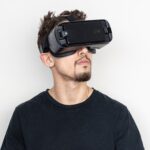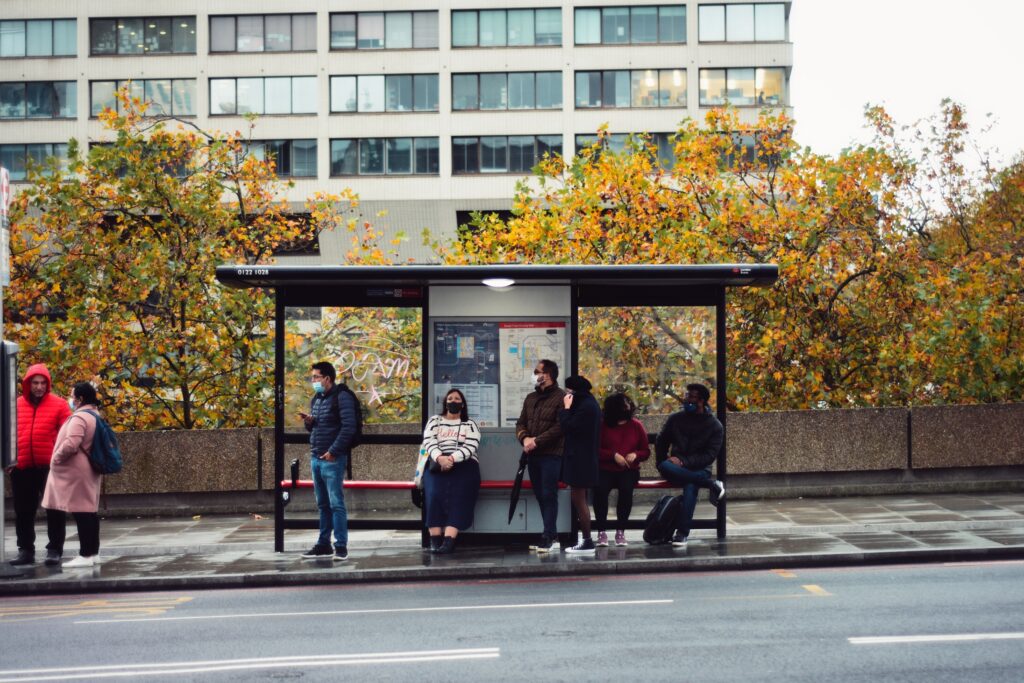
People experiencing psychosis can find the outside world very anxiety-inducing (Veling et al., 2016). Fear of judgment or harm from others is a common thought which can drive people to avoid going outside entirely (Freeman et al., 2002). In its most severe form, avoidance of the outside world can form into agoraphobia; a clinical term referring to fear and avoidance of places or situations in which one may not be able to escape (APA, 2013).
The cognitive model of agoraphobia proposes that this fear is underpinned by irrational beliefs and maintained by behaviours which confirm these beliefs (Salkovskis, 1991). By avoiding being in situations that induce the fear, evidence disconfirming the belief is never encountered and people continue believing the fear is justified. Fear of harm from others in the form of paranoia is common in people with psychosis, and this and other forms of anxiety can lead people to a highly sheltered life (Freeman et al., 2019).
Cognitive behavioural therapy is the leading approach for treatment of agoraphobia (NICE, 2011). It involves breaking the cycle of fear and avoidance by exposing people to anxiety-inducing situations and ceasing behaviours that prevent them from learning that they are safe. The more time spent in the outside world, particularly around other people, the more opportunities to learn that no harm will come. The treatment can be very effective when delivered by an expert, but a major problem is that it requires people to go out into the real world beyond the clinical room where the treatment is delivered. It is not only impractical to conduct therapy in real world settings like a shopping centre, but also confronting to people who have a lot of anxiety, which can lead to poor engagement with treatment (Sanderson & Bruce, 2007). It is also expensive and hard to find the right professional to deliver it (Ince, Haddock & Tai, 2016).
In recognising the significance of agoraphobia in psychosis and the limitations of cognitive behaviour therapy to treat it, researchers based at Oxford University turned to virtual reality (VR); an emerging technology in which users are completely immersed in real world 3D environments via a headset (Bell et al., 2020; Freeman et al., 2008). Through early studies, the group found that VR treatments had potential to be effective for treating social avoidance in people experiencing psychosis (Freeman et al, 2016; Valmaggia et al., 2016). The researchers proposed that the treatment was effective because it allowed people to cease their avoidance behaviours safely and conveniently within virtual social environments in order to learn they were safe around others, leading them to become more comfortable in real world social situations. They also reasoned that by automating VR treatments, there would be less reliance on highly trained clinical psychologists, making the treatment more affordable and accessible.
Over time, the group developed the treatment ‘gameChange VR’ : a VR treatment for agoraphobia in people experiencing psychosis. Following several years of early work to develop the gameChange VR treatment, a landmark randomised controlled trial was conducted to examine its efficacy (Freeman et al., 2019). The researchers hypothesised that:
- The treatment would reduce anxious avoidance and distress in real world situations, and psychiatric symptoms, both immediately after the treatment and at follow up.
- The effects of the intervention would be explained by increased safety beliefs, and reduced threat cognitions and defence behaviours
- The effects would be impacted by the occurrence of negative auditory hallucinations, hopelessness, appearance concerns, and threat cognitions

“This randomized clinical trial aimed to test the efficacy of gameChange VR for reducing avoidance and distress amongst people diagnosed with a psychotic disorder and experiencing agoraphobia”
Methods
The design of the study was a randomised controlled trial in which 346 participants were randomised to receive either 6 sessions of gameChange VR (174 participants) alongside usual care over 6 weeks, or treatment-as-usual (172 participants).
Participants were adults (aged 16 years or older) with a confirmed diagnosis of schizophrenia spectrum disorder or affective disorder with psychotic features, and self-reported difficulties leaving the home due to anxiety. They were recruited through nine community mental health services across the UK. The trial was pre-registered and a protocol was published prior to data collection finishing (Freeman et al., 2019).
The primary outcome measure was avoidance and distress in public situations using the Oxford Agoraphobic Avoidance Scale (O-AS; Lambe et al., 2021). Items measure the level of avoidance and anxiety in common social situations, like leaving the house or being in a café. The scale is brief, freely accessible, has severity ratings that can guide assessment in clinical settings, and was developed specifically for (and with input from) people with lived experience of psychosis. Originally, the researchers used a comparable real-world behavioural measure called the O-BAT (Freeman et al., 2016), however due to COVID-19 lockdown restrictions they switched early in the trial to using the O-AS as a self-report measure which could be completed remotely.
Other measures captured changes in paranoia, anxiety and avoidance, and secondary outcomes like quality of life and recovery. Importantly, the researchers also looked at whether there were any harms from the treatment by tracking adverse events in both groups.
The authors also included measures to look at how the treatment worked based on theory developed from earlier research (Freeman et al., 2019). Specifically, they measured beliefs about sense of safety around others and threat from others, and use of defence behaviours.
Measures were completed at baseline, after the intervention period of 6 weeks, and a follow up at 26 weeks, and were administered by a researcher blind to what group the participants were allocated to.
The gameChange VR intervention involved being guided through different social environments in VR by an automated virtual ‘coach’ who encouraged participants to engage in tasks which elicited anxiety whilst dropping defence behaviours. Within environments like a doctor’s office or café, participants were encouraged by the virtual coach to engage in increasingly anxiety-inducing behaviours, like moving closer to other people in a crowded room or doing something to be at the centre of attention. Whilst they did these tasks, the coach actively encouraged them to let go of defence behaviours like avoiding eye contact, and supported them to progress through the levels and test their fears. There were six sessions lasting 30 minutes each and the treatment was delivered in the participants home or at a clinic. The treatment was developed by a multidisciplinary team with significant input from people with lived experience.
For the trial, the treatment was supervised and supported by a staff member (peer worker, assistant psychologist or clinical psychologist) who was present in the room whilst the participant received the treatment. They also encouraged participants to apply the learning from the sessions to the real world by setting homework tasks.
Results
Immediately after receiving gameChange VR, participants had lower scores on the primary outcome of avoidance and distress in public situations compared to those that received treatment-as-usual, however these differences were small (O-AS avoidance cohen’s d = 0.18, O-AS distress cohen’s d = 0.26). Amongst the small number of participants whom the researchers collected outcomes using the original O-BAT measure, larger effect sizes were found immediately after treatment (O-BAT avoidance cohen’s d = 0.89, O-AS distress cohen’s d = 0.86), however these did not differ from the O-AS at 26 weeks follow up. There were no differences in secondary outcomes except for progress of recovery in the gameChange group, which improved a lot more compared to the treatment-as-usual group immediately after the treatment (cohen’s d = 2.83) and at follow up (cohen’s d = 1.71).
The improvements in avoidance and distress in social situations were explained by a reduction in beliefs about threat and less use of avoidance behaviours in these situations, but not beliefs about safety.
Looking at moderators of treatment outcomes, participants with more intense beliefs about social threat improved the most, but the severity of negative auditory hallucinations, hopelessness, appearance concerns and the participant’s age or gender didn’t make a difference.
There were no differences in the number of adverse events between groups, suggesting the VR treatment was equally as safe as regular treatment.

There were small improvements in avoidance and distress in social situations after gameChange and the intervention was found to be safe.
Conclusions
gameChange VR is an effective intervention for improving avoidance and distress in social situations for people diagnosed with a psychotic disorder, particularly for those with more severe avoidance and distress. The treatment works by helping people to drop their avoidance behaviours and learn not to fear others in the virtual environment.

gameChange VR works by helping people drop avoidance behaviours and fears in the virtual environment, making them more prepared for the real world.
Strengths and limitations
The gameChange VR trial was not just a high quality randomised controlled trial, but the culmination of decades of empirical research which provided a strong theoretical foundation for the intervention. The result is a novel, innovative and effective intervention which provides a framework for a new generation of digitally enhanced treatments for people experiencing debilitating mental health conditions.
Key strengths are:
- The research design was a randomised controlled trial with a large sample size, which provides the highest quality of evidence for treatment efficacy
- A lived experience reference group was heavily involved in the research, ensuring the intervention was relevant and acceptable for the people it was designed to help
- The trial was pre-registered, a protocol was published and the reporting in this publication was very clear and transparent
- Examining the mechanisms of how the intervention works and why strengthens the theoretical basis of the intervention and the models from which it was built
- The intervention had a very strong theoretical foundation that was validated by numerous experimental studies and pilot work.
Key limitations are:
- The unfortunate need to change the measure of the primary outcome due to the pandemic did appear to effect results, with a behavioural measure of avoidance having larger effects than the self-report measure. The researchers provide several explanations for this. The most significant explanation for the smaller effects was that the social isolation requirements due to the pandemic inhibited participant’s engagement with the outside world. In an intervention aiming to increase social contact, it is not surprising that it was less effective following government orders to reduce social contact. This explanation would suggest that it is less to do with the outcome measure and instead the unique circumstances in which the intervention was delivered. If this was indeed the reason, these results are likely to underestimate the efficacy of the intervention as the world returns to normal.
- It is not possible to determine from this trial design to what degree the involvement of a worker to supervise the delivery of the intervention might have contributed to the effects. Further, the mixture of different types of workers with different levels of training (e.g. peer worker or clinical psychologist) means it is not possible to draw conclusions about the level of training required for the intervention to be effective. This is important because if it doesn’t matter, then delivery with a peer worker will make the treatment much more accessible and affordable than a clinical psychologist. Confirming this will be a top priority for future research.
- The authors examined a number of moderators, however further work needs to be done to examine who this intervention is best suited to.
- The authors originally developed the treatment for people with persecutory delusions (i.e. unfounded beliefs about intention of harm from others) with a heavy focus on social anxiety. I was left a bit perplexed about the movement to agoraphobia as the underlying model given the social emphasis in prior work and in the gameChange VR treatment. I was also surprised that paranoia did not improve following the intervention whereas reductions in perceived social threat was a main mediator of the effects on avoidance.

Confirming the level of training required to support delivery of this intervention, and whom it is most suited for, is a top priority for future research.
Implications for practice
This study provides definitive evidence that the gameChange intervention is safe and can be effective for treating avoidance of social situations in people diagnosed with a psychotic disorder, particularly for those with more severe avoidance. As most clinicians would probably not have used VR for treatment before, or perhaps never even heard of it, the results provide assurance that this novel approach is not going to harm the people they work with and may provide an effective adjunct to usual care for improving social difficulties in psychosis populations.
Along with the AVATAR trial which has also arisen from the UK (Craig et al., 2018), it is clear that VR-based interventions are showing compelling results and are likely to become more commonplace in clinical settings in the near future. Unlike AVATAR, gameChange VR is a semi-automated therapy and is unlikely to require significant clinical expertise to deliver. This is important because access to evidence-based treatment for conditions like psychosis, and the professionals that deliver them, is highly limited in the UK and beyond. A treatment like gameChange VR could be delivered by someone without significant clinical training, reducing cost, complexity and making the treatment more accessible to everyone.
The researchers behind gameChange VR have already commenced plans for implementation to make this treatment accessible within the UK, and I suspect other countries in the near future.

Virtual reality based interventions are likely to become more commonplace in clinical settings in the near future.
Statement of interests
None to disclose
Links
Primary paper
Freeman, D., Lambe, S., Kabir, T., Petit, A., Rosebrock, L., Yu, L. M., … & West, J. (2022). Automated virtual reality therapy to treat agoraphobic avoidance and distress in patients with psychosis (gameChange): a multicentre, parallel-group, single-blind, randomised, controlled trial in England with mediation and moderation analyses. The Lancet Psychiatry.
Other references
American Psychiatric Association (2013). Diagnostic and Statistical Manual of Mental Disorders: DSM-5. American Psychiatric Association, Arlington, VA
Bell, I. H., Nicholas, J., Alvarez-Jimenez, M., Thompson, A., & Valmaggia, L. (2020). Virtual reality as a clinical tool in mental health research and practice. Dialogues in clinical neuroscience, 22(2), 169.
Craig, T. K., Rus-Calafell, M., Ward, T., Leff, J. P., Huckvale, M., Howarth, E., … & Garety, P. A. (2018). AVATAR therapy for auditory verbal hallucinations in people with psychosis: a single-blind, randomised controlled trial. The Lancet Psychiatry, 5(1), 31-40.
Freeman, D. (2008). Studying and treating schizophrenia using virtual reality: a new paradigm. Schizophrenia bulletin, 34(4), 605-610.
Freeman, D., Bradley, J., Antley, A., Bourke, E., DeWeever, N., Evans, N., … & Clark, D. M. (2016). Virtual reality in the treatment of persecutory delusions: randomised controlled experimental study testing how to reduce delusional conviction. The British Journal of Psychiatry, 209(1), 62-67.
Freeman, D., Garety, P. A., Kuipers, E., Fowler, D., & Bebbington, P. E. (2002). A cognitive model of persecutory delusions. British Journal of Clinical Psychology, 41(4), 331-347.
Freeman, D., Taylor, K. M., Molodynski, A., & Waite, F. (2019). Treatable clinical intervention targets for patients with schizophrenia. Schizophrenia Research, 211, 44-50.
Freeman, D., Yu, L. M., Kabir, T., Martin, J., Craven, M., Leal, J., … & Waite, F. (2019). Automated virtual reality (VR) cognitive therapy for patients with psychosis: study protocol for a single-blind parallel group randomised controlled trial (gameChange). BMJ open, 9(8), e031606.
Ince, P., Haddock, G., & Tai, S. (2016). A systematic review of the implementation of recommended psychological interventions for schizophrenia: rates, barriers, and improvement strategies. Psychology and Psychotherapy: Theory, Research and Practice, 89(3), 324-350.
Lambe, S., Bird, J. C., Loe, B. S., Rosebrock, L., Kabir, T., Petit, A., … & Freeman, D. (2021). The Oxford Agoraphobic Avoidance Scale. Psychological Medicine, 1-11.
National Institute of Clinical Excellence (2011). Generalised Anxiety Disorder and Panic Disorder in Adults: Management. Clinical Guideline.
Salkovskis, P. M. (1991). The importance of behaviour in the maintenance of anxiety and panic: A cognitive account. Behavioural and Cognitive Psychotherapy, 19(1), 6-19.
Sanderson, W. C., & Bruce, T. J. (2007). Causes and management of treatment-resistant panic disorder and agoraphobia: A survey of expert therapists. Cognitive and Behavioral Practice, 14(1), 26-35.
Valmaggia, L. R., Day, F., & Rus-Calafell, M. (2016). Using virtual reality to investigate psychological processes and mechanisms associated with the onset and maintenance of psychosis: a systematic review. Social psychiatry and psychiatric epidemiology, 51(7), 921-936.
Veling, W., Pot-Kolder, R., Counotte, J., van Os, J., & van der Gaag, M. (2016). Environmental social stress, paranoia and psychosis liability: a virtual reality study. Schizophrenia bulletin, 42(6), 1363-1371.
Photo credits
- Photo by Adrian Deweerdt on Unsplash
- Photo by Alexas_Fotos on Unsplash
- Photo by Diana Polekhina on Unsplash
- Photo by Sandy Ravaloniaina on Unsplash
- Photo by Hello I’m Nik on Unsplash
- Photo by Billetto Editorial on Unsplash

This is really informative, thank you for this!